Overhead pressing is one of the most effective ways to build your shoulders.
And while there are many overhead pressing exercises to choose from, one that definitely deserves a place in your program is the seated overhead press.
That’s because it allows you to lift heavy weights safely and progress regularly, which is vital for gaining muscle and strength.
In this article, you’ll learn what the seated barbell overhead press is, why it’s beneficial, which muscles it works, how to do it with proper form, the best seated overhead press alternatives, and more.
What Is the Seated Overhead Press?
The seated overhead press is an upper-body exercise that involves pressing a barbell vertically over your head from a seated position.
It’s almost identical to the standing overhead press, the only difference being you perform the seated overhead press while sitting on a bench in the middle of a squat rack instead of standing.
Seated vs. Standing Overhead Press: Which Is Better?
The standing press outshines the seated variation when it comes to full-body muscle engagement, training most of the muscles in your upper body and many more in your lower body, too.
The seated press tops the standing variation in other areas, though:
- It emphasizes the shoulder muscles more.
- It allows the use of slightly heavier weights.
- It’s easier to perform correctly.
In other words, they both have benefits, which is why it doesn’t make sense to think in terms of seated vs. standing overhead press. Instead, you’ll likely benefit from including both exercises in your program.
A good way to do this is to include the seated overhead press in your program for 8-to-10 weeks of training, take a deload, then replace the seated overhead press with the standing overhead press for the following 8-to-10 weeks of training.
Then, you can either continue alternating between the exercises every few months or stick with the one you prefer.
This is how I personally like to organize my training, and it’s similar to the method I advocate in my fitness books for men and women, Bigger Leaner Stronger and Thinner Leaner Stronger.
(And if you’d like even more specific advice about how you should organize your training to reach your health and fitness goals, take the Legion Strength Training Quiz, and in less than a minute, you’ll know the perfect strength training program for you. Click here to check it out.)
Seated Overhead Press: Benefits
Most people think of the seated barbell overhead press as a shoulder exercise.
While it’s true that the seated overhead press trains all three heads of the deltoids to a high degree, it also effectively trains several other major upper-body muscle groups, including your back, abs, pecs, and arms.
It’s also well suited to helping you gain muscle and strength because:
- It’s a barbell exercise, so it allows you to train with heavy weights, which is important for getting stronger over time.
- It doesn’t require as much balance as the standing variation, so learning and performing it is more straightforward.
- It’s easy to set up, so you don’t have to waste energy or risk injury getting into position the way you might during the dumbbell overhead press.
- It allows you to add weight in small increments, which is important for long-term progress.
Moreover, the seated overhead press allows you to handle 10-to-20% more weight and progress faster than the standing variation, which means it’s excellent for progressively overloading your shoulder muscles.
The only downside compared to the standing press is that it doesn’t activate as much whole-body muscle, giving you slightly less muscle-building bang for your buck.
Seated Overhead Press: Muscles Worked
The main muscles worked by the seated overhead press are the . .
Here’s how they look on your body:
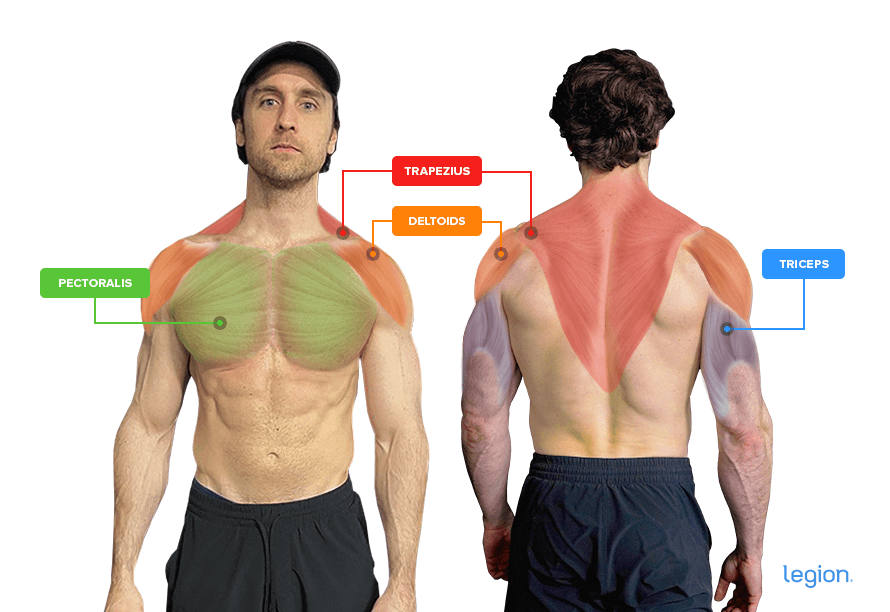
How to Do the Seated Overhead Press
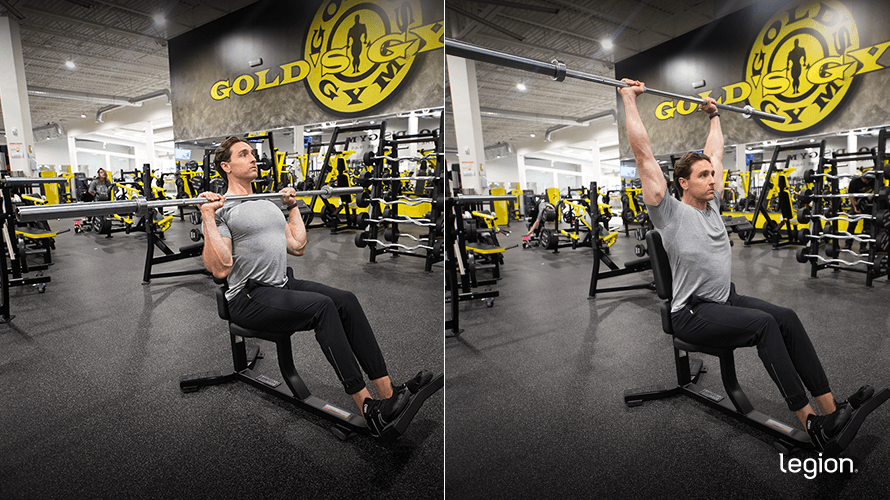
The best way to learn how to do the seated overhead press is to split the exercise into three parts: set up, descend, and press.
Step 1: Set Up
Place an adjustable bench (set to the upright position) in the middle of a squat rack facing out of the rack. Sit in the seat, press your back against the backrest, and reach your arms overhead. Take note of the height of your wrists in relation to the rack—this is the height you should set the barbell on the hooks.
Adjust the rack’s hooks to the desired height, set the barbell in the hooks, and sit down. Plant your feet on the floor just outside of shoulder-width with your knees bent at 90 degrees, and drive through your feet to push yourself against the backrest.
Grip the barbell as hard as possible with your palms facing away from you and thumbs wrapped around the bar, slightly wider than shoulder-width. Hold the bar low in your hands, closer to your wrists than your fingers. Bend your wrists just enough to allow the bar to settle into the base of your palms, but not fold back at a 90-degree angle.
Here‘s how your wrists should look:
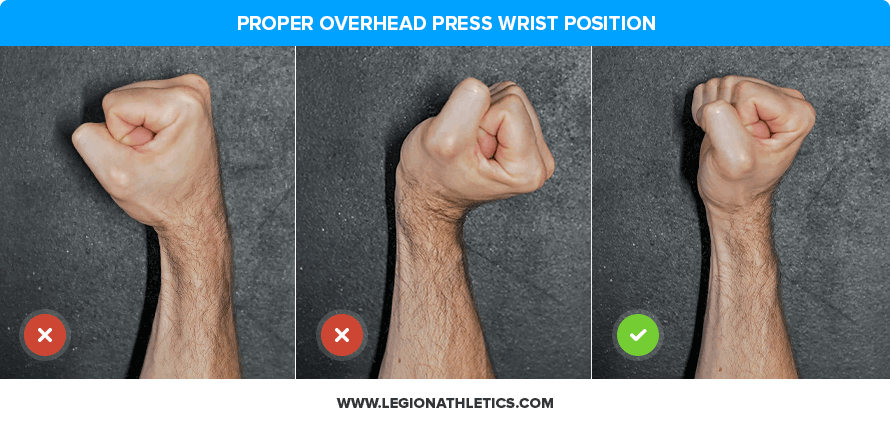
Take a deep breath into your stomach, lift the bar off the hooks, and hold it with your arms straight, directly above your head.
Step 2: Descend
Keeping your elbows flared at around 45 degrees relative to your torso, lower the bar to the height of your collarbone, taking care to move your head backward as the bar nears the top of your head.
Don’t let the barbell fall toward your torso or try to lower it slowly—the entire descent should be controlled but take less than a second.
Step 3: Press
While driving your feet into the floor and your back against the backrest, push the bar toward the ceiling. As soon as the bar passes your eyes, push your head and chest forward and under the bar. Keep pushing until your arms are straight and you return to the starting position.
Here’s how it should look when you put it all together:
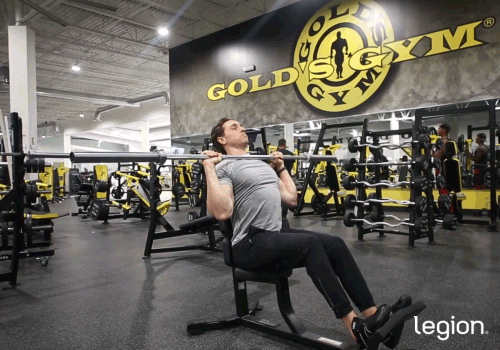
The Best Seated Overhead Press Alternatives
1. Seated Overhead Dumbbell Press
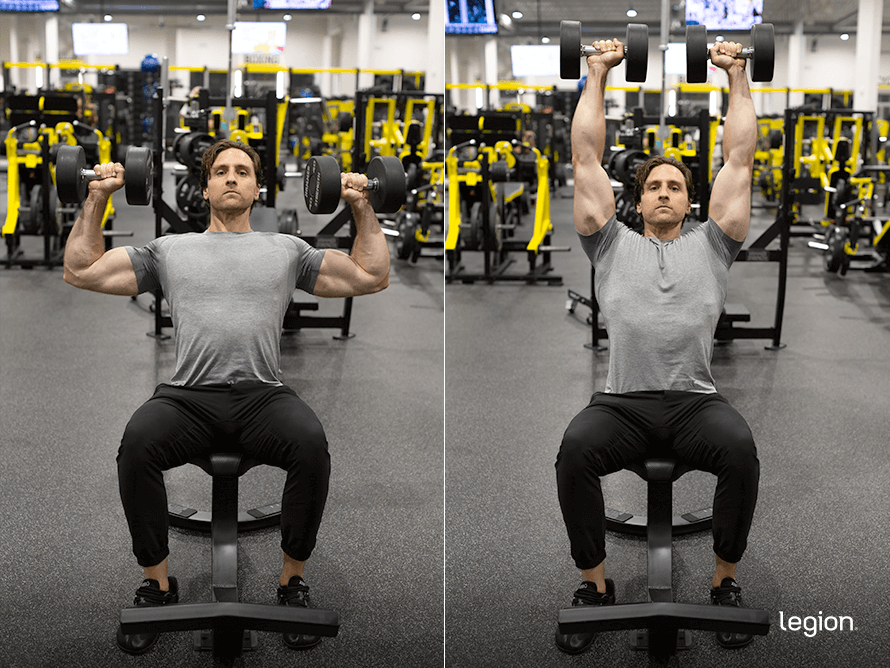
The seated overhead dumbbell press trains the shoulder, triceps, and upper chest similarly to other overhead pressing exercises. The main benefits of the seated overhead dumbbell press are that it has a longer range of motion than the barbell variation, which tends to be better for muscle growth, and it trains each side of your body independently, so it’s a good exercise for finding and fixing muscle imbalances.
2. Machine Seated Overhead Press
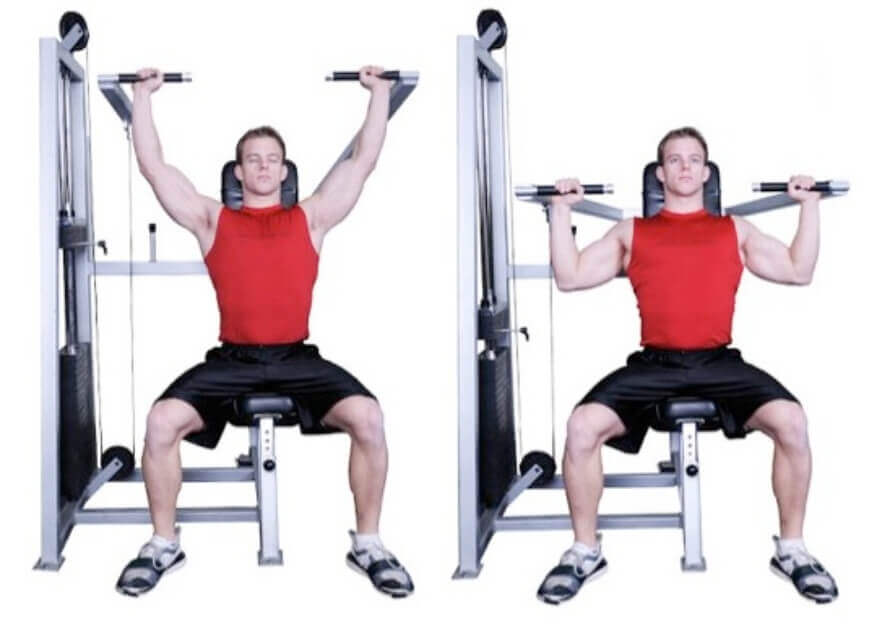
Generally speaking, machines aren’t as effective as free weights for gaining muscle and strength. Still, the machine seated overhead press is a viable option if you’re working around an injury or want to change up your training.
3. Arnold Press
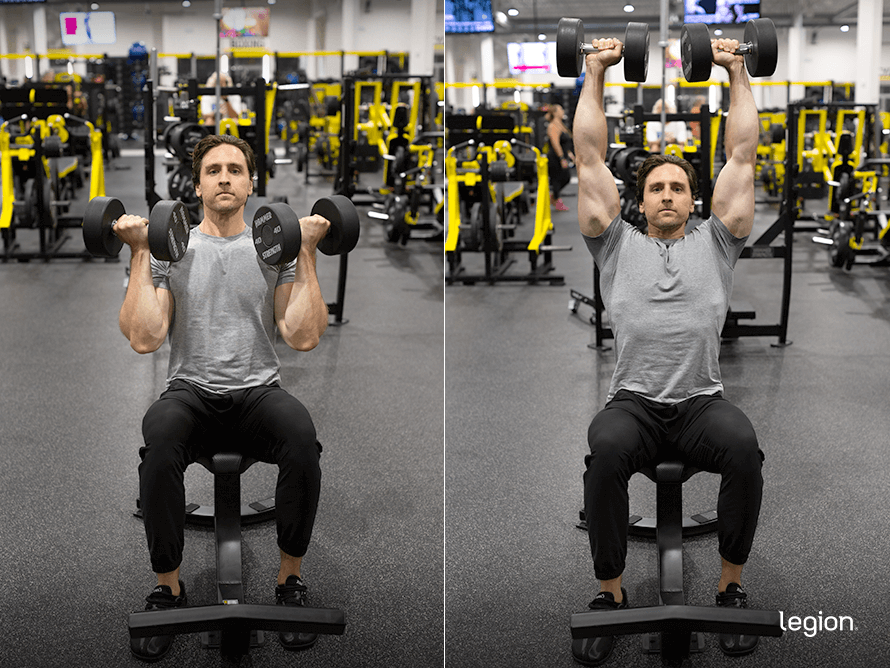
The Arnold press trains the shoulders in a similar way to the seated overhead press, but because of the way you rotate your wrists in the Arnold press, you emphasize your side delts slightly more. That said, you can lift more weight on the seated barbell overhead press than on the Arnold press, which likely makes the gains from both exercises more or less equal.
Scientific References +
- Saeterbakken, A. H., & Fimland, M. S. (2013). Effects of body position and loading modality on muscle activity and strength in shoulder presses. Journal of Strength and Conditioning Research, 27(7), 1824–1831. https://doi.org/10.1519/JSC.0B013E318276B873
- Raizada, S., & Bagchi, A. (2017). Comparison among the EMG activity of the anterior deltoid and medial deltoid during two variations of dumbbell shoulder press exercise. Indian Journal of Public Health Research and Development, 8(4), 653–656. https://doi.org/10.5958/0976-5506.2017.00411.9










